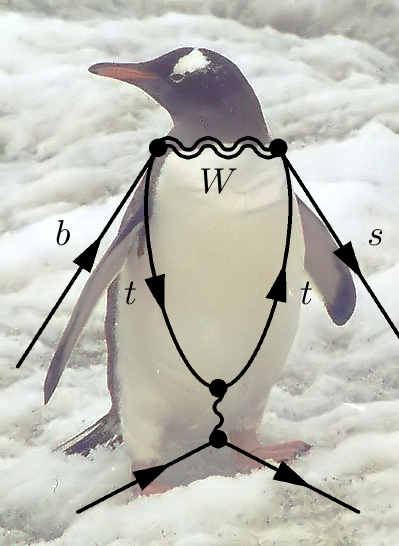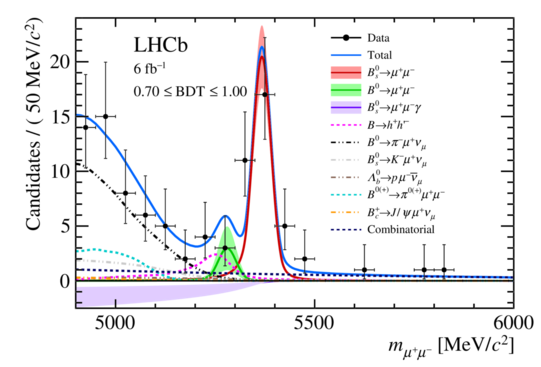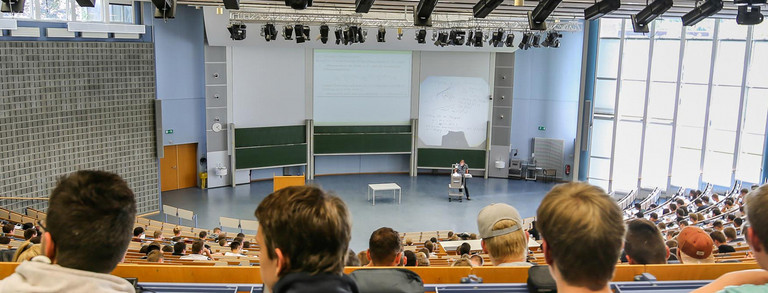LHCb Rare decays
Why study rare decays?
Particle physicists aim to describe nature with the help of fundamental particles and their interactions. The Standard Model of particle physics successfully describes most processes that surround us in our everyday life. At the same time, there are strong hints from astrophysical observations that our current knowledge is incomplete. We also cannot explain the mass hierarchy of the fundamental particles. These are some of the reasons for searching for a more fundamental theory of nature, which might feature new particles or interactions.
The direct searches (this approach was famously used to discover the Higgs boson) did so far not provide a strong hint for the existence of new fundamental particles beyond the Standard Model.
However, in the history of particle physics indirect measurements for new effects have led to significant breakthroughs. For example, the experimental observation of the violation of the charge-parity symmetry, called CP violation, in kaon decays led to the prediction of the existence of a third quark family in the SM. However, the direct discovery of these quarks happened much later. As another example, the discovery of the B-meson mixing allowed us to indirectly predict the large mass of the top quark eight years before this quark was directly discovered.
To perform such indirect measurements today, we look at the processes strongly suppressed in the Standard Model, as these processes are sensitive to the equally tiny new-physics effects. Interference between the known (Standard Model) and yet-unknown (New Physics) contributions can modify the decay rates, angular distributions and other observables.
A famous historical example is the discovery of the smallness of the rate of the neutral kaon decaying to two muons. The explanation of this result allowed to predict the existence of the charm quark several years before its discovery (see this Wikipedia article for more details).
The described process is a flavour-changing neutral current (FCNC) that is highly suppressed in the Standard Model.
Rare b decays at the LHCb experiment
The LHCb experiment at the Large Hadron Collider (LHC) was designed to study the properties of the particles that contain b quarks. Thanks to the high mass of such particles, they can decay through various decay channels, with the probability of each decay channel (“branching fraction”) being about several per cent or smaller. Some channels are more suppressed than others due to known conservation laws in the Standard Model. We call the decays rare if their branching fraction is as tiny as 10⁻⁶ to 10⁻⁹. Even more suppressed processes are referred to as “very rare decays”.
In our group, we focus on two main classes of measurements with rare decays:
- Electroweak-penguin decays with b→sℓ⁺ℓ⁻ transitions
- Very rare decays
We are analysing the full dataset recorded by the LHCb experiment during 2011-2018 and working with the data collected with the upgraded LHCb detector that started operating in 2022.
Searching for the very rare processes requires us to work at the forefront of the field, investing in developing software tools such as machine-learning algorithms, tools for the statistical treatment of our data, and of course, novel physics ideas.
Electroweak penguin decays
One important process we study in our group is the process of the b quark decaying into an s quark and two oppositely-charged leptons (b→sℓ⁺ℓ⁻). Such decay, which is an FCNC process, cannot occur at the “tree-level” and only occurs via loop-level quantum fluctuations in the Standard Model, making it suppressed. One possible loop-level description of this process is by so-called electroweak penguin decays (see this Wikipedia article for the origin of the name). An essential feature of these processes is that one can obtain precise Standard Model predictions and test them experimentally.
There is a number of anomalies observed in decay rates and angular distributions, which are intriguing and motivate further study: see this article for an overview.

Our group actively contributes to the measurements of branching fractions and tests of lepton-flavour universality. We also expand this field by discovering previously unobserved decays of such type (e.g. those involving b-baryons) and studying new observables in these decays. These studies allow getting a better understanding of the processes of interest.
Purely leptonic final states
The decays of neutral B⁰ and Bₛ⁰ mesons to the final states of two charged leptons are another example of a rare loop-level process. However, they also receive so-called “helicity suppression” due to the left-handed nature of the weak interaction. Our group has contributed to the first observation of these decays; our subsequent work has significantly improved our precision on their branching fractions. Here one can find recent publications on the measurement of the decays B⁰→μ⁺μ⁻ and Bₛ⁰→μ⁺μ⁻: (PRL 128 (2022) 041801), B⁰→e⁺e⁻ and Bₛ⁰→e⁺e⁻ (PRL 124 (2020) 211802), and B⁰→μ⁺μ⁻μ⁺μ⁻ and Bₛ⁰→μ⁺μ⁻μ⁺μ⁻ (JHEP 03 (2022) 109) with significant contributions from our group.
In addition, our group has contributed to searches for neutral-meson decays into four charged leptons.

Searches for decays forbidden in the SM
Searching for the processes that involve transitions forbidden in the Standard Model is another way to search for new physics effects. One example is searching for lepton-flavour violation. These searches include processes such as B→Keμ, or tau-lepton decaying to three muons. Some new-physics models that explain the anomalies seen in b→sℓ⁺ℓ⁻ processes predict the existence of such decays. Our experimental limits on such processes provide independent constraints on these models. Here one can find a recent publication searching for the decay B→Keμ (PRL 123 (2019) 241802).

